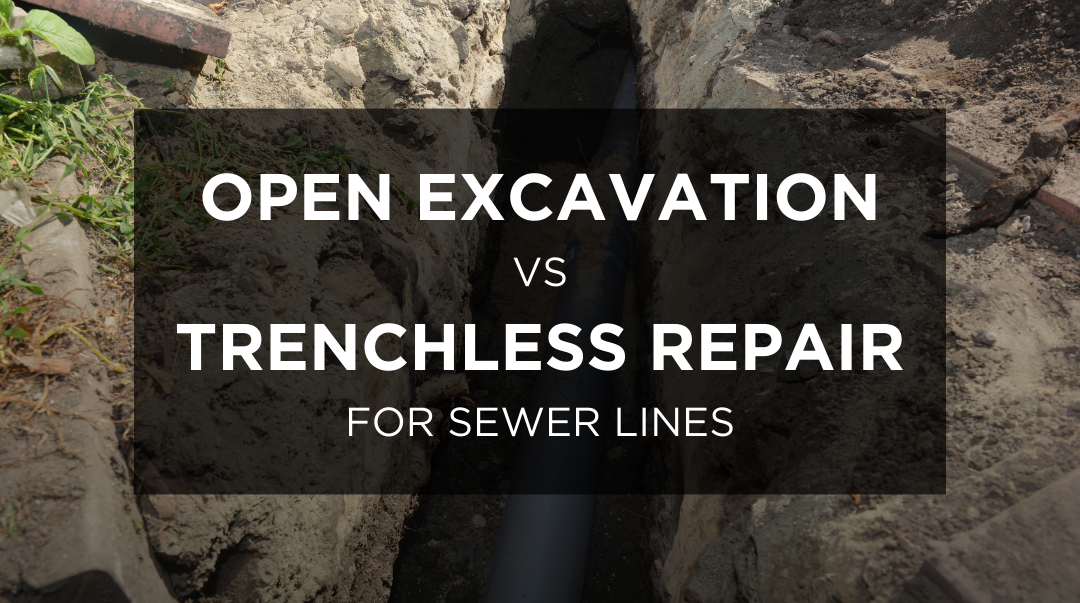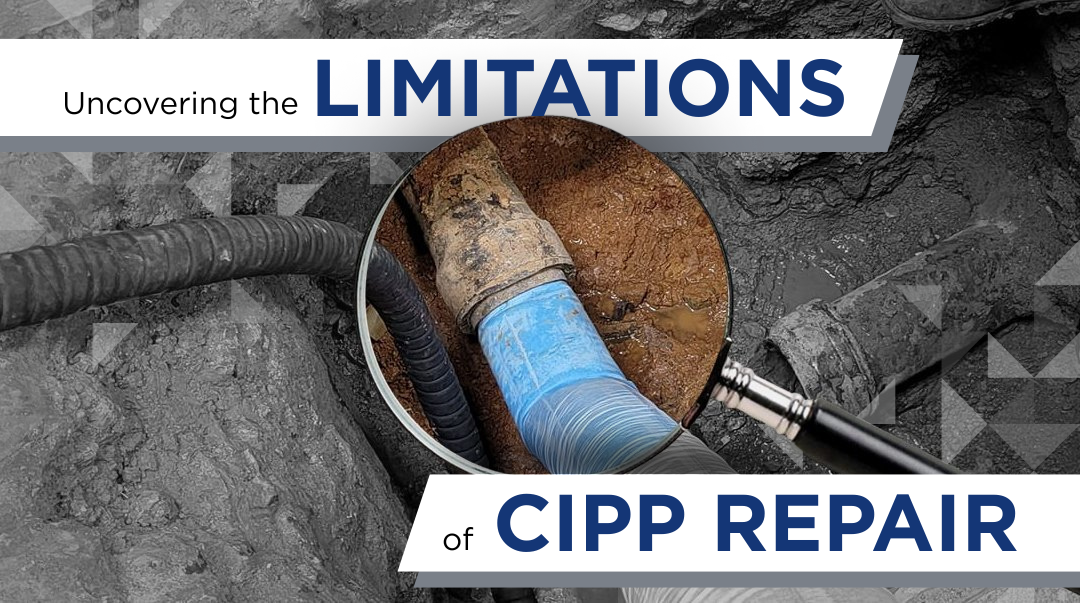Open Excavation vs. Trenchless Repair: Why Smart Pipe Repair Companies Are Choosing CIPP Technology to Win More Customers and Increase Profits
Updated July 2025
The trenchless pipe rehabilitation market is projected to reach $8.4 billion by 2030, a 4.6% annual growth rate. For pipe repair companies, choosing between excavation and CIPP lining isn't just about repair methodology—it's about competitive advantage and profitability.
This guide helps contractors considering CIPP services and established companies looking to better market their trenchless capabilities.
The Market Reality: Why CIPP Demand Is Skyrocketing
44% of North America's water infrastructure has passed its estimated lifespan, creating massive repair opportunities. Property owners and municipalities want less disruptive, more cost-effective solutions.
CIPP renewal costs 57% less than excavation for small pipes, 63% less for medium pipes, and 18% less for large applications. These savings create competitive pricing opportunities and higher profit margins.
Open Excavation vs. CIPP: The Complete Business Comparison
The most apparent difference between open excavation and trenchless repair is digging. But for plumbing companies, there’s a lot more to consider before investing in a sewer repair method for your business. Let’s start by looking at what each method takes to complete.
Traditional Open Excavation Process
Breaking it down to its most basic components, there are nine essential steps to any open excavation sewer repair, starting with locating the sewer line itself. From there, the process requires careful work to keep from disturbing other buried utilities, all while digging down to the sewer line through hardscapes, sod, and concrete to complete the repairs.
Locate the sewer line
Locate utilities near the sewer line
Mark the excavation area
Remove obstructions
Dig the trench
Cut out tree roots
Assess the repair needs
Replace the sewer line
Rehab the trench and any landscaping, hardscaping, or other damage
CIPP Trenchless Process
Without the need to physically map out the location of the sewer line, trenchless repair typically starts with a visual inspection with a CCTV system. After prepping materials and locating an access point, which is typically an interior line or a small pit close to the damaged pipe, the line is cleaned. The liner is then installed and cured, with a final inspection before reinstatement.
Inspect the pipe
Prep materials
Locate access points
Clean the pipe
Install the liner
Cure the resin
Inspect the finished job
Reinstate service
In both open excavation and trenchless repair, the work requires training and preparation to keep teams and customers safe. And in both cases, the results are clean, secure sewer lines that will last for decades. But the amount of disruption for the two jobs is quite different. And this is where companies should determine the best investment.
The Customer Experience Advantage: Why CIPP Wins More Contracts
Most residential repair work could benefit more from trenchless repair than open excavation, but if your company focuses on large-scale repair and replacement work, open excavation might be necessary in more situations.
Pros and Cons of Open Excavation
Open excavation offers a more versatile repair option than trenchless repairs, but it comes with some drawbacks that could be detrimental in some situations. While direct access to the lines helps ensure the quality of the repairs, it also means disrupting the areas around the sewer line.
Pros:
The work can be physically inspected
Any type of issue can be addressed, including bellies and collapses
Cons:
Sewer lines must be located accurately to avoid disrupting other utilities
Typically requires destruction of adjacent features like landscaping and concrete
Longer timelines for repairs and rehab of property
Often more expensive than trenchless methods
Trenching is considered highly dangerous, especially for deeper excavations
Pros and Cons of Trenchless Repair
Although a direct physical inspection of the work isn’t possible, trenchless repairs like CIPP lining use video inspections that can make sure the liner is properly cured and ready for reinstatement. But trenchless repairs save both time and money by avoiding landscape tear-out.
Pros:
Fast turnaround for repairs
No need for repairing or replacing features disrupted by trenches
No heavy machinery required
Cons:
Requires specialized equipment and training
Safety, Convenience, and Expense
When these pros and cons are weighed against each other, trenchless repair comes out ahead more often than open excavation. It’s safer, more efficient, less expensive, and faster. And with proper CCTV inspections, trenchless sewer repairs can be just as effective as open excavation repairs.
Marketing Your CIPP Services: Key Messages That Win Customers
Your future customers won’t always know what makes CIPP a better option than open excavation and replacement, but with the right knowledge, you can make it an easy decision to go with CIPP instead.
For Residential Customers
Lead with convenience and cost savings:
"Same-day sewer repair with no digging—keep your beautiful landscaping intact"
"50-year warranty pipe lining at 20-50% less than open excavation and restoration"
"No heavy machinery, and no restoration headaches"
For Commercial Customers
Focus on business continuity:
"Minimal business disruption with repairs completed in hours, not days"
"Little to no parking lot excavation or customer access issues"
"Predictable project timelines without weather-related delays"
For Municipal Clients
Emphasize infrastructure efficiency:
"Extend pipeline life 50+ years at 57% less cost than replacement"
"No traffic disruption or expensive road restoration requirements"
"Proven technology with measurable ROI for infrastructure budgets"
The Business Case: CIPP Investment vs. ROI
So what does it take to add CIPP to your pipe repair business? Although initial investment may seem steep, the new opportunities you’ll earn with trenchless repair will pay it back quickly.
Margins for CIPP repairs are better than open excavation, plain and simple. Without the expense and time required for rehabbing landscape and hardscape features, your repairs make more money, even with competitive pricing. And faster completion enables more projects per month while improving customer satisfaction.
"CIPP Requires Expensive Equipment"
Reality: With financing options available, we make CIPP accessible to companies of all sizes. T3 Lining Supply offers comprehensive financing solutions to get you started with minimal upfront cost, ensuring positive cash flow from project one.
"Training is Too Complex"
Reality: Our professional CIPP training programs provide hands-on, location-based instruction that gets teams productive quickly. T3 Lining Supply offers on-site training and 24/7 expert support that lets your team complete every job with confidence.
"Limited Applications"
Reality: Modern CIPP technology handles 90% of typical sewer line problems, including root intrusion, joint separation, and pipe deterioration. Only complete collapses or severe structural damage require excavation alternatives.
When to Choose Each Method: Strategic Decision Framework
But even with CIPP repair’s advantages, there may be times when you’ll have to opt for complete replacement, including open excavation. While rare, you should be prepared to talk with your customers about both options so they know what’s possible in their situations.
CIPP is Optimal for:
Pipe diameters 4” to 48” inches with structural integrity
Root intrusion and joint separation issues
Residential and commercial applications
Projects requiring minimal surface disruption
Time-sensitive repairs with same-day restoration needs
Cost-conscious customers seeking long-term solutions
Excavation Remains Necessary for:
Complete pipe collapse situations
Pipe bellying or grade adjustments
New installation projects and system expansions
Situations requiring immediate physical access for complex repairs
Projects where surface restoration is already planned
Building Your CIPP Service: Implementation Strategy
Ready to get started? Here’s a simple structured plan to go from brand new to the market to making profit with your CIPP repairs:
Phase 1: Market Assessment (Weeks 1-2)
Analyze local competition and CIPP adoption rates
Survey customer base for trenchless service interest
Evaluate target markets (residential vs. commercial focus)
Phase 2: Technology Selection (Weeks 3-4)
Partner with T3 Lining Supply for equipment needs
Plan training needs and programs
Secure funding or financing options for equipment investments
Phase 3: Team Development (Weeks 5-8)
Begin technician training program
Develop standard operating procedures and quality protocols
Create customer communication and project management systems
Phase 4: Market Launch (Weeks 9-12)
Execute targeted marketing campaigns highlighting CIPP advantages
Develop referral partnerships with complementary service providers
Track performance metrics and adjust strategies based on results
The Future is Trenchless: Positioning for Long-Term Success
The pipe repair industry's future belongs to companies embracing trenchless technology. With aging infrastructure and customer preferences shifting toward less disruptive solutions, CIPP represents competitive necessity.
Companies investing in CIPP today capture market share from excavation-only competitors. Superior customer experience, higher margins, and growing demand make CIPP adoption essential for pipe repair companies looking to grow.
Ready to transform your pipe repair business with CIPP technology? T3 Lining Supply provides everything you need to succeed: custom-designed equipment, third-party tested materials, comprehensive training programs, and 24/7 expert support. Our financing options and proven implementation strategies ensure your CIPP investment generates positive returns from day one.
Contact T3 Lining Supply today to discover how CIPP technology can differentiate your company, increase profits, and win more satisfied customers in the growing trenchless repair market.






